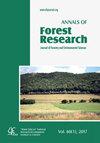Effects of thinning on soil nutrients in a chronosequence of Chinese fir in subtropical Chinaforests
IF 1.7
3区 农林科学
Q2 FORESTRY
引用次数: 1
Abstract
Thinning is a common silviculture technology in forestry, but there is considerable uncertainty about the changes of soil nutrients due to thinning practice in different aged forests. The influence of light thinning (reduction of 20% of stand density) on soil organic carbon (SOC) and other mineral elements (N, P, K, Cu, Fe, Zn, Mn and S), as well as soil pH and soil bulk density were investigated in 6-, 13-, and 23-year-old growth stands of Chinese fir forests in subtropical China. Six 10m ×10m plots (three thinning and three non-thinning plots) were set up in each aged forests. Soil samples were taken from different soil layers from these plots for nutrient analysis. Results showed that SOC increased 59.4, 48.9, and 62.0% in topsoil layer (0-30 cm) in 6, 13, and 23 year-old growth stands, respectively when compared to the control, and the content of N increased by 20.5, 44.6, and 54.1% corresponding after two year post-thinning. In the thinned forests, soil P slightly increased at 6- and 23 year-old growth forests dude to microclimates were improved, and K decreased because of leaching. The response of micronutrients Cu, Fe, Zn and Mn to thinning varied in all examined Chinese fir forests. Thinning decreased soil bulk density and soil pH in 6 and 23 year-old growth stands. Our study provided scientific references for sustainable management of soil nutrients under forest operations in Chinese fir forest ecosystem in subtropical China.疏伐对中国亚热带杉木时序土壤养分的影响
疏伐是林业中常见的造林技术,但由于不同年龄森林的疏伐实践,土壤养分的变化存在相当大的不确定性。研究了轻度疏伐(林分密度降低20%)对中国亚热带6、13、23年生杉木林土壤有机碳(SOC)和其他矿质元素(N、P、K、Cu、Fe、Zn、Mn和S)以及土壤pH和土壤容重的影响。每片老林设置6个10m×10m样地(3个疏伐样地和3个不疏伐样点)。从这些地块的不同土层中采集土壤样本进行养分分析。结果表明,与对照相比,6年生、13年生和23年生林分表层(0-30cm)的SOC分别增加了59.4%、48.9%和62.0%,间伐两年后,N含量分别增加了20.5%、44.6%和54.1%。在疏伐林中,土壤P在6年和23年生的森林中略有增加,这是由于小气候的改善,而K则因淋滤而降低。微量营养元素Cu、Fe、Zn和Mn对杉木疏伐的反应各不相同。疏伐降低了6年生和23年生林分的土壤容重和土壤pH值。本研究为亚热带杉木林生态系统林下土壤养分的可持续管理提供了科学依据。
本文章由计算机程序翻译,如有差异,请以英文原文为准。
求助全文
约1分钟内获得全文
求助全文
来源期刊

Annals of Forest Research
FORESTRY-
CiteScore
2.20
自引率
11.10%
发文量
11
审稿时长
12 weeks
期刊介绍:
Annals of Forest Research is a semestrial open access journal, which publishes research articles, research notes and critical review papers, exclusively in English, on topics dealing with forestry and environmental sciences. The journal promotes high scientific level articles, by following international editorial conventions and by applying a peer-review selection process.
 求助内容:
求助内容: 应助结果提醒方式:
应助结果提醒方式:


